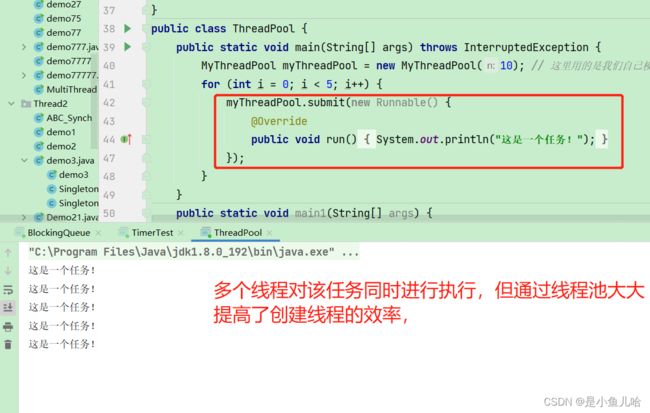《多线程案例》阻塞队列、定时器、线程池、饿汉与懒汉模式
目录
一、阻塞队列的模拟实现
阻塞队列实现思路
代码
测试代码
二、定时器的模拟实现
三、线程池的模拟实现
标准库中的线程池
代码
线程池的优点
四、单例设计模式
饿汉模式与懒汉模式
一、阻塞队列的模拟实现
阻塞队列实现思路
- 通过 "循环队列" 的方式来实现.
- 使用 synchronized 进行加锁控制.
- put 插入元素的时候, 判定如果队列满了, 就进行 wait. (注意, 要在循环中进行 wait. 被唤醒时不一定队列就不满了, 因为同时可能是唤醒了多个线程).
- take 取出元素的时候,
代码
// 阻塞队列——wait,线程安全——加锁
// 阻塞队列的模拟实现
public class MyBlockQueue {
private int[] array = new int[100];
private int head;
private int tile;
volatile private int size;// 防止内存可见性问题
public MyBlockQueue() {
array = new int[100];
}
// 入队列
public void put(int value) throws InterruptedException {
synchronized (this) {
if (size == array.length) {
this.wait();
}
array[tile] = value;
tile++;
if (tile == array.length) {
tile = 0;
}
size++;
// 但我们的插入结束后,队列就不空了,就应该唤醒我们的队列为空等待(take中的等待)
this.notify(); // 即使没人在等待,多写一个也要等待
}
}
// 出队列
public Integer take() throws InterruptedException {
int ret;
synchronized (this) {
if (size == 0) {
this.wait(); // 在出队列的时候,如果队列为空,就等待
}
ret = array[head];
head++;
size--;
if (head == array.length) {
head = 0;
}
// 当我们出了一个队列后,队列就不满了,唤醒队列为满的等待(put中等待)
this.notify();
}
return ret;
}
}测试代码
import java.util.concurrent.LinkedBlockingQueue;
import java.util.concurrent.BlockingDeque;
// 生产者,消费者模型,用到了我们自己模拟实现的阻塞队列
public class BlockingQueue {
public static void main(String[] args) {
// BlockingQueue blockingQueue = new BlockingQueue();
// java.util.concurrent.BlockingQueue queue = new LinkedBlockingQueue<>(); // 阻塞队列
MyBlockQueue queue = new MyBlockQueue();
Thread consumer = new Thread(() -> {
while (true) {
try {
int ret = queue.take();
System.out.println("消费元素" + ret);
} catch (InterruptedException e) {
e.printStackTrace();
}
}
}); // 消费者
consumer.start();
Thread producer = new Thread(() -> {
int n = 0;
while (true) {
try {
queue.put(n);
System.out.println("生产元素" + n);
Thread.sleep(300);
} catch (InterruptedException e) {
e.printStackTrace();
}
n++;
}
}); // 生产者
producer.start();
}
}
二、定时器的模拟实现
// 定时器的模拟实现
import java.util.concurrent.PriorityBlockingQueue;
class MyTask implements Comparable{
// 任务要干啥
public Runnable command;
// 任务在什么时候干,任务推迟的时间
public long time;
public MyTask(Runnable command, long after) {
this.command = command;
this.time = System.currentTimeMillis() + after; // 记录下任务执行的绝对时间
}
// 执行任务的run方法,直接在内部调用command的run方法
public void run() {
command.run();
}
public long getTime() {
return time;
}
@Override
public int compareTo(MyTask o) {
return (int) (this.time - o.time);
}
}
// 自己创建的定时器类
class MyTimer {
//
private Object object = new Object();
// 使用优先级阻塞队列来保存要执行的若干个队列,按时间来确定优先级(这是标准库中的)
public static PriorityBlockingQueue queue = new PriorityBlockingQueue<>();
// command要执行的顺序是什么,after在什么时间执行该任务
public void schedule(Runnable command, long after) {
MyTask myTask = new MyTask(command, after);
synchronized (object) {
queue.put(myTask);
object.notify(); // 唤醒当前线程
}
}
public MyTimer() {
// 在这里启动一个线程
Thread t = new Thread(() -> {
while (true) {
// 循环过程中, 就不断的尝试从队列中获取到队首元素.
// 判定队首元素当前的时间是否就绪. 如果就绪了就执行, 不就绪, 就不执行.
synchronized (object) { // 因为线程调度是随机的,可能在任务塞回队列之后,wait之前。有其他的任务加入(也没有成过唤醒该线程)
while (queue.isEmpty()) {
try {
object.wait(); // 在等待过程中,通过唤醒,也可以执行其他任务
} catch (InterruptedException e) {
e.printStackTrace();
}
}
MyTask myTask = null;
try {
myTask = queue.take();
} catch (InterruptedException e) {
e.printStackTrace();
}
// 时间到了
if (myTask.getTime() <= System.currentTimeMillis()) {
myTask.run();
}
// 时间还没到
else {
// 时间还没到, 塞回到队列中
queue.put(myTask);
try { // 当wait陷入等待,thread线程暂时停止执行,但main主线程还可以插入新的任务,thread线程会提前唤醒
object.wait(myTask.getTime() - System.currentTimeMillis()); // 在等的时候,通过唤醒,其他代码也可以执行
} catch (InterruptedException e) {
e.printStackTrace();
}
}
}
}
});
t.start();
}
}
public class TimerTest {
public static void main(String[] args) throws InterruptedException {
MyTimer myTimer = new MyTimer();
myTimer.schedule(new Runnable() {
@Override
public void run() {
System.out.println("3333");
}
}, 6000);
myTimer.schedule(new Runnable() {
@Override
public void run() {
System.out.println("2222");
}
}, 4000);
myTimer.schedule(new Runnable() {
@Override
public void run() {
System.out.println("1111");
}
}, 2000);
}
}
三、线程池的模拟实现
标准库中的线程池
使用 Executors.newFixedThreadPool(10) 能创建出固定包含 10 个线程的线程池.
返回值类型为 ExecutorService
通过 ExecutorService.submit 可以注册一个任务到线程池中
代码
// 线程池的模拟实现
import java.util.concurrent.BlockingQueue;
import java.util.concurrent.ExecutorService;
import java.util.concurrent.Executors;
import java.util.concurrent.LinkedBlockingQueue;
class MyThreadPool {
// BlockingQueue 是一个接口. 真正实现的类是 LinkedBlockingQueue, java标准库中内置的阻塞队列
private BlockingQueue queue = new LinkedBlockingQueue<>(); //这个队列就是 "任务队列" 把当前线程池要完成的任务都放到这个队列中.
// 再由线程池内部的工作线程负责完成它们.
// 核心方法, 往线程池里插入任务.
public void submit(Runnable runnable) throws InterruptedException {
queue.put(runnable);
}
// 设置线程池中最大的线程数
// 构造方法中,就需要创建一些工作线程,让这些工作线程负责完成上述执行任务的工作
public MyThreadPool(int n) {
for (int i = 0; i < n; i++) {
Thread t = new Thread(() -> {
//Thread.currentThread()返回当前线程对象引用
//.isInterrupted()测试是否当前线程已被中断 中断返回true,否则返回false
//总的说,这句就是无限判断当前线程状态,如果没有中断,就一直执行while内容
while (!Thread.currentThread().isInterrupted()) {
try {
Runnable runnable = queue.take();
runnable.run();
} catch (InterruptedException e) {
e.printStackTrace();
}
}
});
t.start();
}
}
}
public class ThreadPool {
public static void main(String[] args) throws InterruptedException {
MyThreadPool myThreadPool = new MyThreadPool(10); // 这里用的是我们自己模拟实现的线程池
for (int i = 0; i < 5; i++) {
myThreadPool.submit(new Runnable() {
@Override
public void run() {
System.out.println("这是一个任务!");
}
});
}
}
public static void main1(String[] args) {
// 借助静态方法来创建实例,像这样的方法叫做”工厂方法", 所对应的设计模式,就叫做“工厂模式"
// 当前的线程池中最多有10个线程,线程池存在的目的就是未来让程序员不必创建新的线程,直接使用已有的线程完成想要进行的工作
// 为什么要有工程模式,通常情况下,创建对象,是借助new,调用构造方法来实现的。但是C++/java里的构造方法,有着诸多限制,很多时候不方便使用
ExecutorService threadPool = Executors.newFixedThreadPool(10);
// ThreadPoolExcutor线程池原始的类,其实也是有构造方法的。Executor里面的各自工厂方法,其实都是针对TreadPoolExecutor这个类进行了new并传入了不同风格的参数,来达到构造不同种类的线程池的目标
threadPool.submit(new Runnable() { // 通过 ExecutorService.submit 可以注册一个任务到线程池中
@Override
public void run() {
System.out.println("这是一个任务!");
}
});
}
}
线程池的优点
- 降低资源的消耗。线程本身是一种资源,创建和销毁线程会有CPU开销;创建的线程也会占用一定的内存。(而我们的线程池是把线程创建好了后,就放到池子了,需要用到线程,直接从池子里取就行,不用系统在进行创建。但线程不用了,直接还是放到池子了,不用系统来销毁。)从池子里取(用户态操作)比系统创建线程(内核态操作)来的快
- 提高响应速度:当任务来时可以直接使用,不用等待线程创建
- 可管理性: 进行统一的分配,监控,避免大量的线程间因互相抢占系统资源导致的阻塞现象。
四、单例设计模式
饿汉模式与懒汉模式
package Thread2;
// 单例设计模式
// 饿汉模式,程序启动立即创建实例,从始至终都是线程安全的
class Singleton {
private static Singleton instance = new Singleton();
public static Singleton getInstance() {
return instance;
}
// 构造方法设为私有,其他的类想来new就不行了
public Singleton() {}
}
// 懒汉模式,程序有需要时候再创建实例,在一开始是不安全的,之后线程安全
class SingletonLazy {
volatile private static SingletonLazy instance = null; // 避免 "内存可见性" 导致读取的 instance 出现偏差, 于是补充上 volatile
public static SingletonLazy getInstance() {
if (instance == null) { // 双重循环,减少锁竞争
synchronized (SingletonLazy.class) {
if (instance == null) {
instance = new SingletonLazy();
}
}
}
return instance;
}
}
public class demo3 {
public static void main(String[] args) {
Singleton.getInstance();
System.out.println(Singleton.getInstance());
}
}



